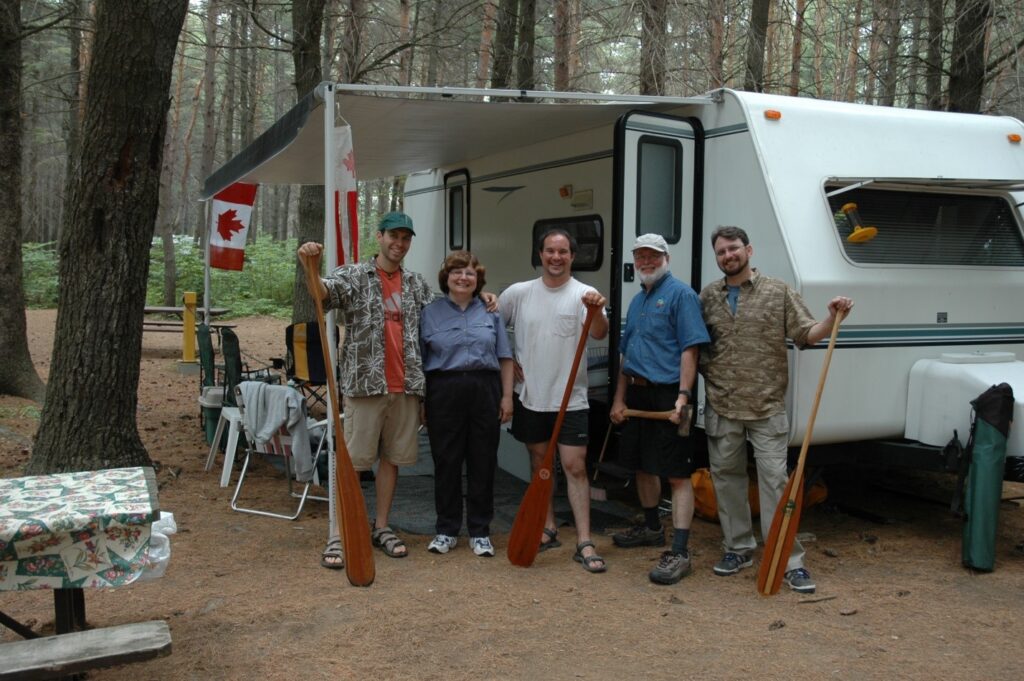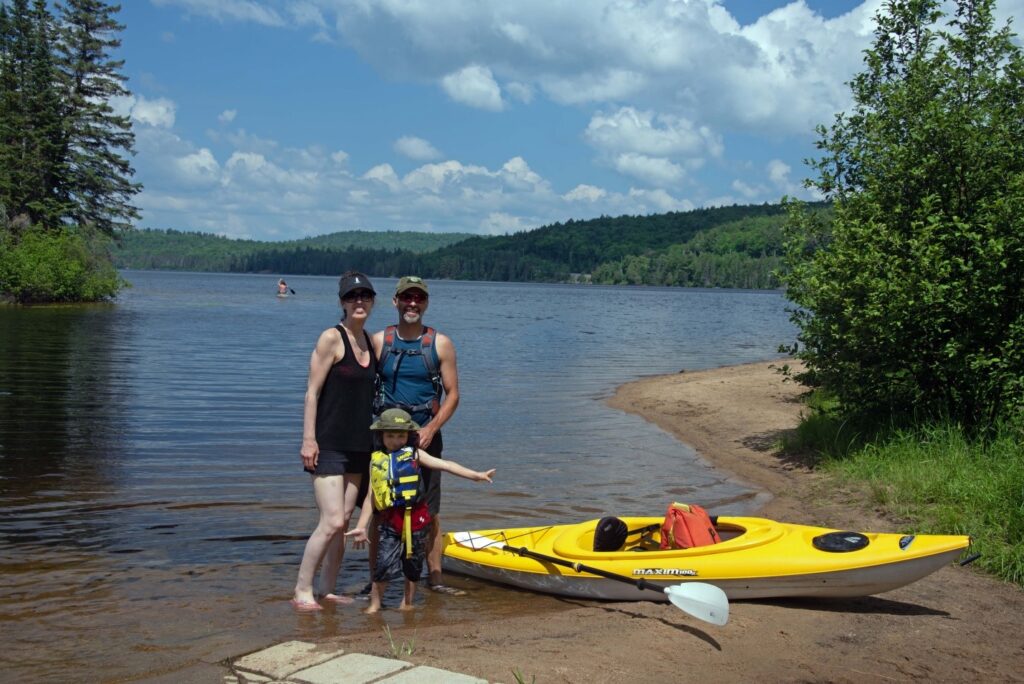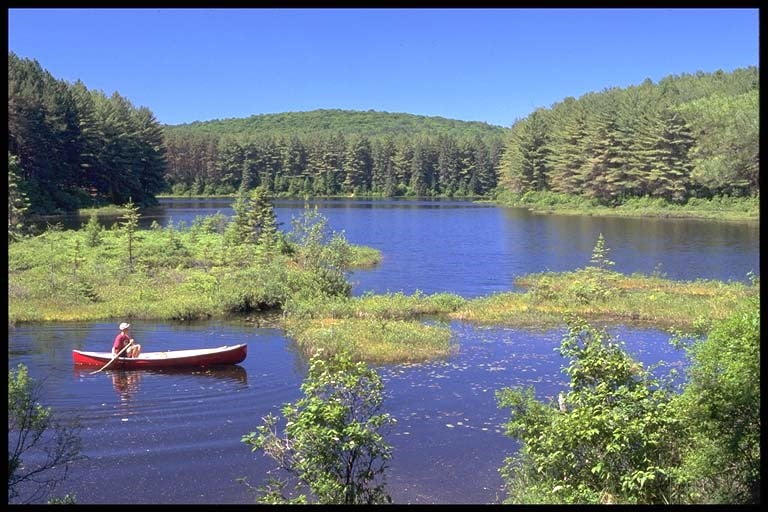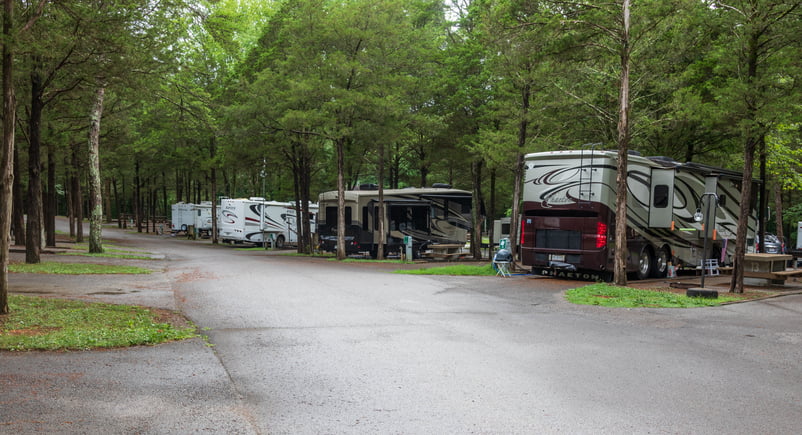The Backstory of Our Back Country
Ontario Provincial Parks contain 19,157 front country campsites. About 42 per cent of these 8,000 sites have electrical hookups, and there is an established goal in place to have 50 per cent with electricity. Of these 8,000. approximately 1,600 are designed as trailer/recreational vehicle pull-through sites, which means only 8 per cent are appropriate for RVs. As of the date this was written, Ontario Provincial Parks has no stated goal on the number of sites to be available to Ontario citizens or the number designed for RVs. Our hope with this well-researched series is by voicing our concerns and increasing public knowledge, we will change this in the future – especially as RV use and ownership continue to rise as the pandemic limits international travel.

Figure 1: Paul (the author) and Cathy Eagles with family in front of their 4th generation trailer in a provincial park. Paul is a retired professor of park management and environmental planning at the University of Waterloo. He has been an RV camper for over 40 years, and currently has his 6th generation of recreational trailer. He learned to back up a trailer on the family farm, starting at age 10.
In their parks and recreation planning, municipalities often rely on comparative standards for facilities and programs. Examples include 3 hectares of parkland per 1,000 people, or 1 swimming pool for 100,000 people. Ontario Parks has no standards for the number of campsites for Ontario citizens, or the features on those campsites. In the absence of agency goals or standards, this final article in the 3-part Ontario Parks series published over the last several months will form a proposal that will hopefully reach the offices and ears of those involved in today’s park planning efforts.
In the last 15 years, Ontario Parks has conducted numerous expansion projects, adding more campsites suited for recreational vehicles at Bronte Creek, Inverhuron, and Mikisew, as well as 75 electrical campsites added at Sandbanks in 2017. Previously, in 2013, Ontario closed campgrounds in provincial parks in northeastern Ontario at The Shoals, Obatanga, and Greenwater. These closures occurred because Ontario Parks did not have the funds to maintain the facilities. Disheartening photos of the deteriorating buildings and facilities are now finding their way to the public sphere via the internet. This shows there has been both growth and reduction of available parkland in the past 15 years, with Ontario Parks increasing campsite availability in some parks, and reducing it in others due to rising economic pressure.
The vast majority of the existing campgrounds were built over 50 years ago, and are generally poorly designed for RV manoeuvring. Common problems include turning curves that are far too tight, overhanging branches, restricted movement due to trees, and poorly-maintained campground roads. Very few pull through sites exist, resulting in most RV sites only being accessible if the vehicle backs in. Backing a trailer at a steep angle at a campsite is stressful and a deterrent for many drivers.
Over the years, I have had the unfortunate experience of observing several ‘crunching’ accidents as vehicles struggled to move in cramped spaces and collided with trees. The most recent was in Algonquin Provincial Park in 2020, where a German exchange student damaged her rental van by hitting an overhanging branch she could not see from the driver’s seat. Sympathetic campers, including a long-distance truck driver and professor, rushed to her aid. This included offering advice and the necessary equipment to extract a tree branch out of the side of the RV, and to calm her understandably frazzled nerves.
Upwards but not Onwards – Provincial Parks Unable to Meet Rising Public Demand
In Ontario, there are 340 provincial parks, containing a combined 7.5 million hectares, and 295 conservation reserves, with an additional 1.5 million hectares in Ontario alone. These constitute 8.3 per cent of the province. But only about 100 parks have visitor services and facilities. Ontario’s very large land area in parkland is bigger than all other provinces except for British Columbia. The total Ontario provincial park area is comparable in size to the entire Province of Nova Scotia, so there is no room for argument that there is not enough space in Ontario for new parkland, when there is plenty of land available for new campgrounds.
It seems impossible he population of the province of Ontario has increased by 100 per cent over a 30-year span. Numbers do not lie, however, and show an increase from 7.7 million in 1970 to 14.6 million in 2020. The campsite inventory, however has barely increased in the same period, even though the provincial population has doubled. So, we can say the campsite availability per person has decreased by 50 per cent. Naturally, this leads to supply problems and conflicts.
Ontario Parks has no target for recreational park use, or the number of campsites. The fact that the Ontario population has doubled in the last 50 years has not been taken into account when planning new parks and their continued development. This has resulted in a relatively unmoving and increasingly insufficient campsite supply, despite the continually increasing demand, which now far exceeds supply. If 18,000 campsites were needed for 7.7 million people in 1970, then about 36,000 are needed in 2021 for 15 million.
Getting the System Online and On Track Again
The COVID-19 pandemic in 2020 and 2021 has resulted in a vast increase in demand for camping in Ontario Provincial Parks, given that international travel and interprovincial travel is restricted. The knowledge that outdoor recreation is valuable for social and psychological health has also caused a rise in demand as people search for ways to better their mental health during this time. Using this trend to their advantage, Ontario Parks has a current promotional program emphasizing the value of outdoor recreation for human health (Figure 2).
As I have learned more and researched the system for this series, the registration system has been criticized unfairly in my opinion, when the real problem is demand exceeding supply. If there were enough campsites available, the registration system would continue to work well, assuming it added the ability to register and book activities that currently are not advertised online, making it a frustrating experience for campers who cannot plan ahead as a result.
As this three-part series, and the busy summer season at Ontario Parks, come to a close, my conclusion and proposed solution is this:
In order to solve the problems currently faced by Ontario Parks and the growing population of Ontario to increase the supply of sites. This is without a doubt, an entirely doable task when you consider the availability of land. The only additional requirement is to adjust the budget so there is capital to support development which in turn will create revenue to help pay for itself.

Figure 2: Cassandra, Ryan and Jasper Eagles involved with healthy family recreation in Algonquin Park.
On March 1, 2021 at 7:00 AM ,the campsite registration system had 10,000 unique users, using 15,000 devices (computers, smartphones, tablets) trying to book for the August 1st holiday weekend. March 1st presents a unique situation in that potential campers can reserve arrival dates on July 29, 30, 31, and August 1; however, only 4,300 sites in total were available for these four days.
This gives an idea of the capacity problem; using demand (10,000 users) and supply (4,300 campsites), one can estimate that Ontario Provincial Park system needs another 5,000 campsites. This number of additional campsites would be an increase of 25 per cent over the current capacity of 19,000.
Population growth suggests that a 100 per cent increase could be easily justified. However, let us work with a 25 per cent catch-up increase to begin for a proposal.
Building the Perfect Environment Requires Ecology, Economy and Empathy
Ontario Parks has the professional staff, expertise, and experience to build and manage new campgrounds. In response to any ecological arguments or concerns, there is an existing environmental assessment process that ensures that any development proposed and created falls within acceptable levels of environmental impact. (Figure 3).
Knowing the information above to be true and factual, I can reasonably propose that 5 different campgrounds be built, each with 1,000 campsites giving a total of 5,000 new sites.
Each campground would include access roads, a water, sewer and electrical system as requirements. Several washroom and shower blocks would also be needed. To keep up with demand, it’s my opinion that at least half of these new site should be accessible for RVs, with 3-way hookups installed on campsites, as well as electricity, water, and sewers. This means that Ontario could finally catch up to Prince Edward Island National Park’s Stanhope Campground that has had 3-way hookups for decades. The other half should have electricity as a minimum, seeing as in 2021, more and more campers, tenters included, use electrical supply facilities. A useful design feature could be a visitor services building, from which guided hikes, evening programs, children’s programs, equipment rentals, and food sales could be based. This could double as an administrative hub for each campground.
A properly-designed and priced campground should be financially self-sufficient from campsite fees alone once it is completed. However, a government grant would be needed for capital construction.
Fact: the Biggest Cost to Consider Doesn’t Exist
What does it cost to build 5,000 campsites? For Ontario Parks, there is no cost for land, which is the most expensive part of campground development, seeing as the parks already exist. If the cost was $20,000 for each campsite, Ontario Parks would need $100,000,000 in capital monies. A reasonable target would be 5,000 new sites built by 2026, in 5 years. This type of money is not available from Ontario Parks’ current budget – it would require a provincial grant.
This capital cost is large for parks, but small compared to provincial-budgeted amounts for other capital projects such as new roads, transit, schools and hospital construction, which run into the billions. The 5 campgrounds should be located in the near north of southern Ontario, which serves the GTA population through Kingston to Ottawa. This would give an average driving distances of 3 to 4 hours per trip for campers, assuming they are coming from the homes of the majority of the Ontario population.
It is time to think big in Ontario Parks, and provide much-needed campsites as a measure to provide better access to healthful outdoor recreation for Ontario citizens. This form of self-care is a much needed boost in present times and ultimately benefits physical and mental wellness.

Figure 3: Pog Lake, being explored by Robert Eagles, is in the center of the largest campground in Algonquin Park. Notice the good ecological condition. This photo reveals that it is possible to design, build and operate a campground and retain ecological integrity.
This article and the series it appears in is designed to start a conversation on improving the quality of campsites as well as accessibility for both people and RVs in Ontario Provincial Parks. This would help in bringing Ontario back to a stable and sustainable demand-supply condition closer to what Ontario citizens enjoyed 50 years ago, and what we soon hope to enjoy again and for many years to come.




